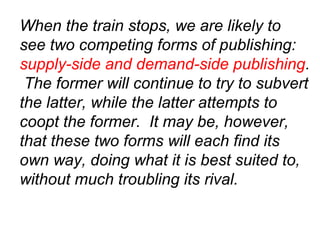What Happens When the Train Stops? Publishing After the Apocalypse by Joseph J. Esposito, CEO, GiantChair
- 1. What Happens When the Train Stops? Publishing after the Apocalypse Joseph J. Esposito Charleston November 2010
- 2. When the train stops, we are likely to see two competing forms of publishing: supply-side and demand-side publishing. The former will continue to try to subvert the latter, while the latter attempts to coopt the former. It may be, however, that these two forms will each find its own way, doing what it is best suited to, without much troubling its rival.
- 3. Prediction is very difficult, especially if it’s about the future. Niels Bohr
- 4. Topics • Vantage: publisher’s perspective • Choosing our metaphors • Punctuated equilibrium • Trends leading to disruption • Supply-side vs. demand-side publishing • “Attention” publishing
- 5. Punctuated Equilibrium • Metaphor from life sciences (associated with Stephen Jay Gould) • Period of abrupt change, followed by a period of relative stability—and then another disruption • Example: the “stable” PC era • Example: the Robert Maxwell Epoch • Disruptors do not disrupt themselves
- 6. Trendspotting #1: Funding • Libraries under budget pressure • Account for 85% of journals revenue • Smaller percentage for academic books (25% for university press titles) • Cancellation of subscriptions makes publishing in some journals less attractive • No obvious prospect for growth; market share struggle among publishers
- 7. Trendspotting #2: Library Bypass • A natural response to the funding prospects • No publisher likes this (library sales have low marketing costs and high margins) • Seeking growth in new territories (e.g., Asia, Eastern Europe), new classes of accounts (e.g., government), and direct to individuals • Requires creative business development and investment
- 8. Trendspotting #3: Supply-side Publishing • Open access is part (but only part of this) • At simplest level, this is “author-pays” • Growth of research, requirement to publish, limited traditional options—all breed demand for new venues • Funding crisis (by reducing subscriptions) fosters greater supply-side publishing
- 9. Trendspotting #4: Direct Marketing • Defined as selling items by the publisher directly to end-users, bypassing channel sales (bookstores, libraries) • Self-published authors are publishers, but effective direct marketing requires scale • Requires creation of new Web infrastructure and management of customer database • Privacy issues loom large
- 10. Trendspotting #5: Proprietary Systems • Perhaps the biggest surprise of all • Amazon: Tyrannosaurus Texts • Also, Apple, Barnes & Noble, etc. with Google entering the fray • Born in part out of copyright concerns • Inevitable: an ecology requires that someone profit from it • Within such a system, peace; outside, turbulence
- 11. Drilling Down: Supply-side Publishing • Represents evolution of open access • Responsive to need to make research results available • Takes advantage of low-cost digital technology • Stimulated by funding crisis, as traditional publishing venues are insufficient for new research • Author-pays model (PLoS, BMC, Hindawi) • Leading to post-publication peer review
- 12. Drilling Down: Demand-side Publishing • Not the same thing as on-demand publishing • The traditional model: user pays • Increasingly migrating toward direct marketing • New emphasis on collecting customer data • The privacy minefield • Need to reduce customer acquisition costs • Migrate to subscriptions for all materials
- 13. “Attention” Publishing • A new D2C model • Borrowing ideas from cable TV and Netflix • Don’t sell books; monopolize attention • Adapt “the Big Deal” to consumers
- 14. Example: Penguin Classics • 1,082 titles in print; on Amazon: $13,413.30. • Suppose lay reader buys 2 Penguin Classics/year @$15 each • $30 retail; $15 to Penguin; gross margin (50% before royalties) to Penguin of $7.50 • Make entire library available to individuals on a direct basis in digital form for $50/year • 700% increase in profit to Penguin • Lay reader now reads more Penguin Classics
- 15. A Probable Thought Process for Publishers • Think beyond the disruption (the punctuation); look for the future stable situation (equilibrium) • Identify who will profit in the new equilibrium • Seek to coopt supply-side publishing (e.g., through cascading peer review) • Beware of any proprietary system you don’t control • Participate in “attention publishing”
- 16. Thank you!
















